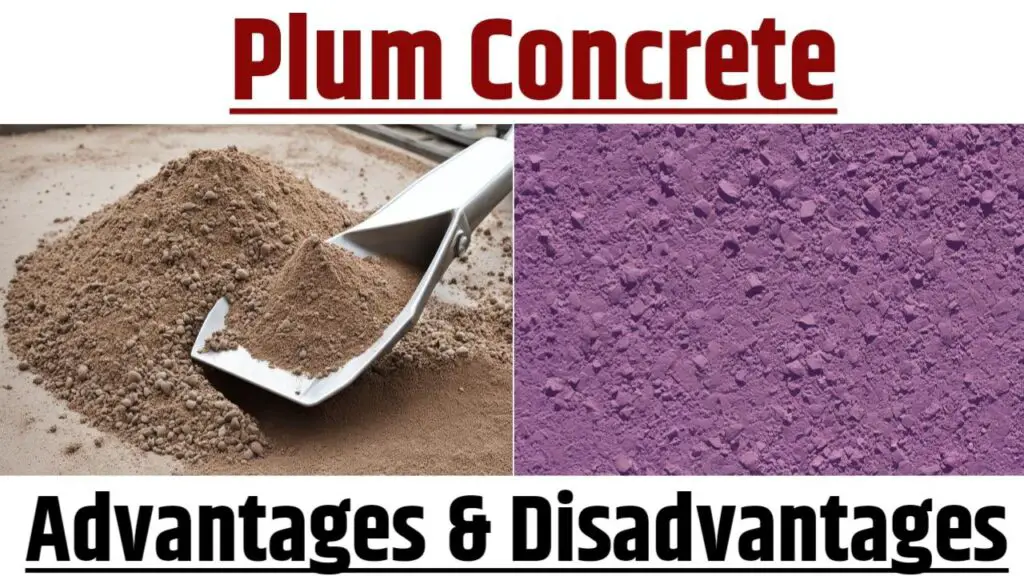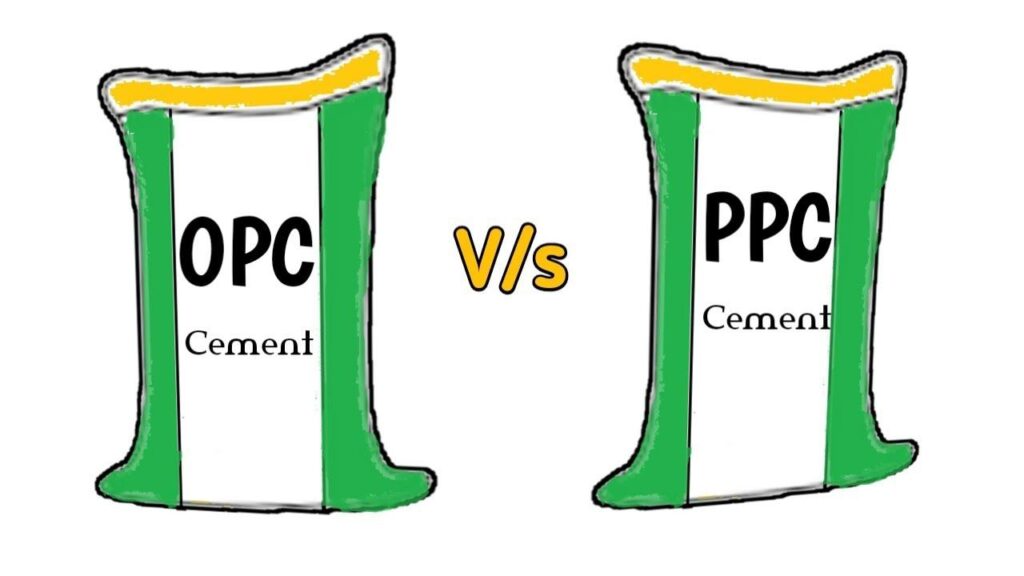As I navigate the intricate world of construction materials, my curiosity leads me to explore the nuances of plum concrete. Commonly posed questions like “What is plum concrete or rubble concrete?” and their purpose in building infrastructures catch my attention. Understanding the purpose of plum concrete and its distinction from plain cement concrete is pivotal, especially within India’s bourgeoning construction industry. This unique composite material is employed not merely as a means to an end but as a strategic approach to enhance durability while maintaining cost efficiency.

Essentially, plum concrete is a mixture that incorporates large stones, referred to as ‘plums’, into the concrete mass to achieve a denser and more economically viable product. It’s intriguing how this mixture diverges from plain cement concrete, especially in its ability to uphold structural integrity while significantly reducing material costs. My foray into rubble concrete’s specifications, ideal ratios, and uses throws light on its versatile applications, ranging from foundational bases for structures to cost-effective solutions in large-scale civic projects.
Key Takeaways
- Plum concrete is a cost-efficient and structurally sound material used in construction.
- Large stones, or ‘rubble’, constitute over 60% of the mix volume, enhancing its strength.
- There’s a discernible difference between plain cement concrete and plum concrete in terms of material composition and cost implications.
- Identifying the ideal concrete ratio is crucial for balancing strength with material savings.
- Understanding the usage protocols for rubble concrete is essential for its effective application in various construction scenarios.
What is Plum Concrete
As I delve into the realm of construction materials, my focus shifts to the often-overlooked but highly resourceful plum concrete. To fully understand the specifications of plum concrete, it is essential to start with its foundational components. rubble concrete is an aggregate mix, where a substantial proportion, often exceeding 60% of the volume, is composed of large stones or boulders known as ‘plums.’ These plums are embedded in a matrix of standard concrete, giving rise to a blend that is both economical and structurally competent for specific construction scenarios.
A closer look reveals that the key to leveraging the full benefits of rubble concrete lies in knowing how to prepare plum concrete. The preparation process begins with selecting appropriately-sized plums—the very stones that give this type of concrete its name. These are typically procured from quarries and can vary in size, but it is crucial that they are clean and free from any debris that could compromise the concrete’s integrity.
The stones are then meticulously combined with the concrete matrix, ensuring proper distribution and alignment within the mix so as to avoid creating pockets of weakness.
Further examination of plum concrete reveals a matrix where the rubble are interspersed with a binding material commonly composed of cement, sand, and aggregates. To guarantee structural stability, this matrix adheres strictly to predetermined ratios, which can fluctuate based on the specific requirements of the project at hand.
Following are basic guidelines for preparing rubble concrete:
- Choose the appropriate size and clean stones for the plums.
- Prepare the concrete mix with precise cement, sand, and aggregate ratios.
- Layer the plums and pour the concrete matrix over them to fill the spaces, ensuring good coverage and lack of voids.
- Compact the mixture thoroughly to enhance the load-bearing capacity.
The context in which rubble concrete is maximally effective includes foundations for heavy structures, such as dams and large buildings, where reducing material costs while preserving structural strength is a priority. Furthermore, its rugged texture and capacity to be molded into irregular shapes make it exceptionally beneficial for handling uneven ground situations.
The success of applying plum concrete lies in the quality of the ingredients, the precision of the mixing process, and the care taken during its placement and compaction. In the subsequent exploration of this substance, we’ll continue to uncover its applications, advantages, and the meticulous attention necessary to craft this robust construction material.
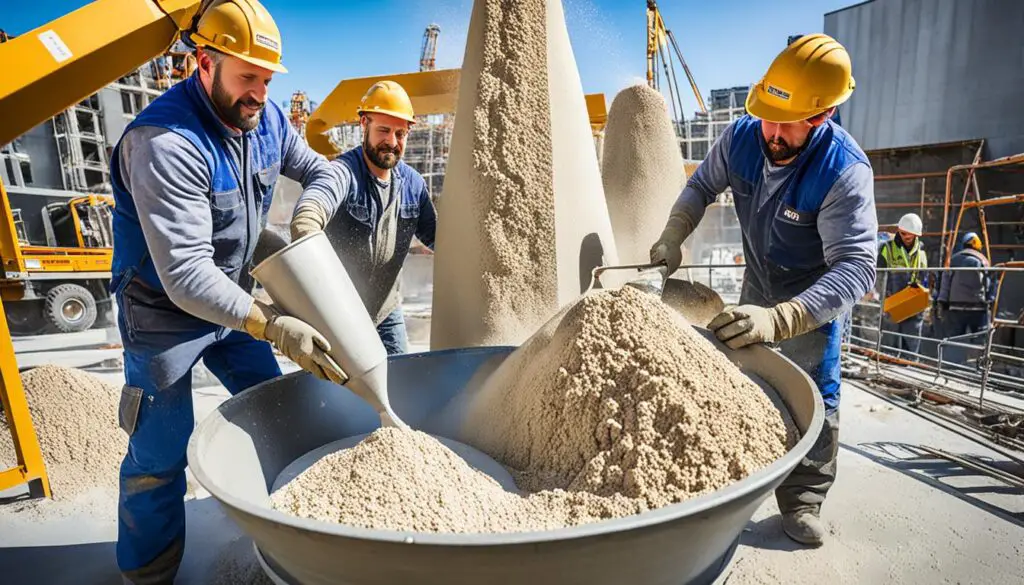
Purpose and Significance of Plum Concrete
The role that plum concrete plays in modern construction cannot be understated, especially when considering its uses & applications within the sector. As a professional in the industry, I have observed that one of the primary drivers for opting for rubbleconcrete is its ability to significantly reduce construction costs. Plum concrete achieves this by supplementing the volume with larger stones, thus economizing on the more expensive cement component. This approach does not compromise on the structure’s integrity but rather, enhances it.
Moreover, the strength properties of rubble concrete are notably superior, which is crucial for supporting structures subjected to various stresses. Its resilience and durability make it an ideal choice for large-scale projects where longevity and stability are paramount. From mass concrete works to foundations that require low-grade concrete, plum concrete has found a multitude of applications, indicative of its versatility and efficiency.
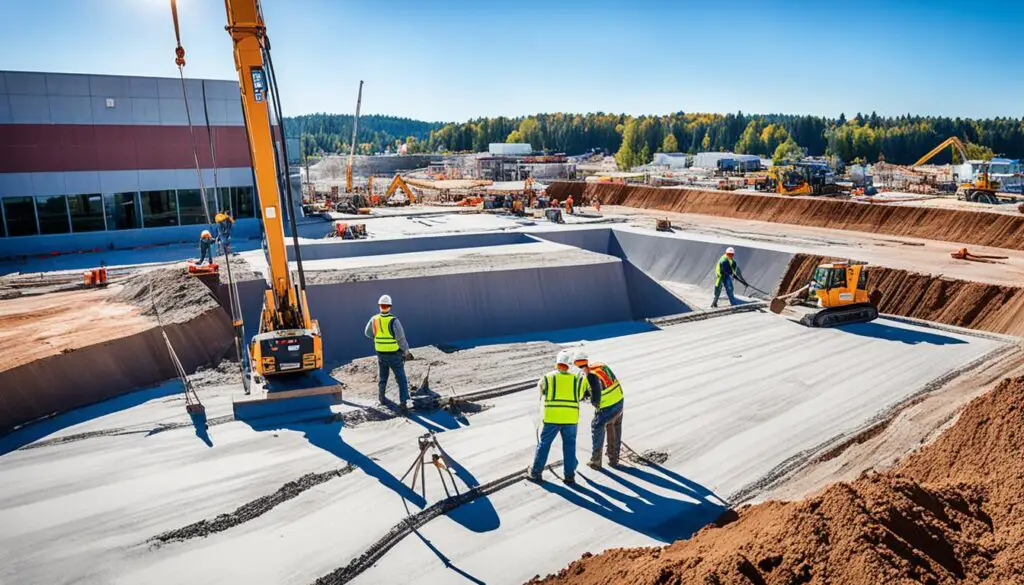
In practice, rubble concrete is strategically used where less stress is anticipated and where rough construction is permissible. Below is an encompassing list of its prominent applications:
- Mass filling applications under foundations
- Construction of gravity dams and embankments
- Erosion control structures such as ripraps
- Sub-base material for roadways and walkways
- Landscaping purposes to create aesthetic yet functional structures
Understanding these applications reinforces the material’s importance and why it remains a steadfast choice in the Indian construction landscape. A notable reflection of its extensive use is observed in the following table, which outlines typical structures where rubble concrete is employed:
| Structure Type | Use of Plum Concrete | Reason for Use |
|---|---|---|
| Foundations | Mass filling and base preparation | Cost-effective and strong support for upper structures |
| Dams | Core construction material | Enhanced strength and reduction in hydrostatic pressure |
| Road Constructions | Sub-base layering | Improved load distribution and durability |
| Erosion Control | Riprap structures | Resistance to water flow and weathering |
| Landscaping | Decorative and functional elements | Aesthetic appeal combined with structural integrity |
With these insights, it’s clear to see the practicality and benefits of employing plum concrete in various construction scenarios, each resonating with the demands of modern infrastructure requirements.
Key Specifications of Plum Concrete
As we dive into the essential specifications of plum concrete, it’s crucial to understand the intricate relationship between its material composition and the rubble concrete ratio. These two factors determine the effectiveness of the construction procedure of plum concrete.
Material Composition
The backbone of rubble concrete lies in its unique material composition. Large stones or boulders, often referred to as ‘plums’, are embedded within a matrix of concrete. These large aggregates can make up to 60-70% of the volume, which are combined with fine aggregates to achieve the strength and stability needed for heavy-duty construction tasks.
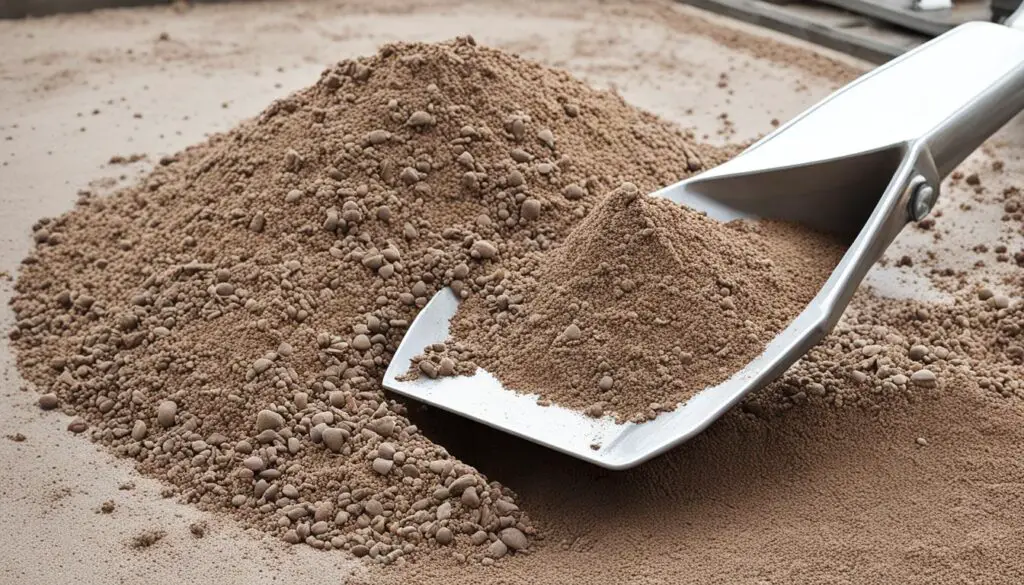
Proportion Guidelines
While material composition is paramount, the proportion guidelines of plum concrete ensure a balance between stability and cost-efficiency. The rubble concrete ratio plays a pivotal role in achieving the desired quality. It’s generally recommended that the ratio of large stones to concrete mix falls within the range of 70:30 to 40:60, depending on the specific requirements of the project at hand.
| Component | Volume Percentage | Function |
|---|---|---|
| Large Stones (Plums) | 40-70% | Structural Strength |
| Concrete Mix | 60-30% | Adhesion and Filling |
By adhering to these proportion guidelines and material specifics, the construction procedure of rubble concrete will uphold the structural integrity of a project while managing expenses effectively. Keeping these critical specifications in mind is vital for any construction professional aiming to utilize plum concrete in their work.
Delineating Plum Concrete From Plain Cement Concrete
When considering the difference between plain cement concrete and rubble concrete, it is pivotal to discern the composition and applications that set them apart. As a construction professional, my aim here is to outline these distinctions clearly for our Indian readership, who may be unfamiliar with the nuanced uses of these materials in their projects.
Plain cement concrete is the more commonly recognized form, used extensively in a variety of applications due to its versatility and relative ease of preparation. It is simply a mix of cement, fine aggregates, and coarse aggregates. On the other hand, plum concrete incorporates larger size stones, known as ‘plums,’ which can account for up to 40-60% of the total volume, reducing the amount of cement necessary and thus impacting the overall project cost significantly.
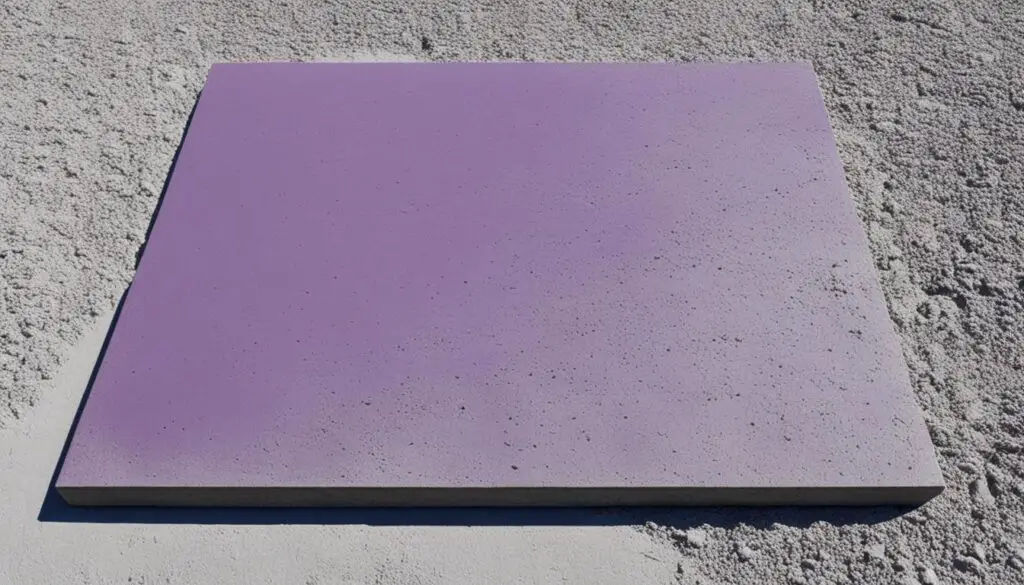
| Feature | Plain Cement Concrete | Plum Concrete |
|---|---|---|
| Stone Size | Smaller aggregates | Large stones/boulders |
| Material Proportion | Higher cement ratio | Lower cement usage |
| Cost | Higher due to cement | Cost-effective |
| Structural Use | Various, including finishes | Primarily for foundations, mass filling |
Differentiating the two, rubble concrete is not used for finishing works or locations where aesthetics are important, a role plain cement concrete often fills. Also, when considering the difference between plain cement concrete and plum concrete, the latter is mainly employed in areas that will bear substantial loads or where there might be high water pressure, such as the base of a dam or for large retaining walls.
Understanding these variations can guide you to make informed decisions for your construction needs in India. The cost implications alone make rubble concrete a favorable alternative in specific situations, while plain cement concrete continues to be indispensable in scenarios where its unique characteristics are required.
The Basics of How to Prepare Plum Concrete
When I consider the intricacies in how to prepare rubble concrete, it’s essential to pay attention to both the choice of materials and the step-by-step procedure. As a method utilized in India and globally, understanding the correct approach can lead to savings on material costs and improvements in construction efficiency. Allow me to share the knowledge I’ve accrued.
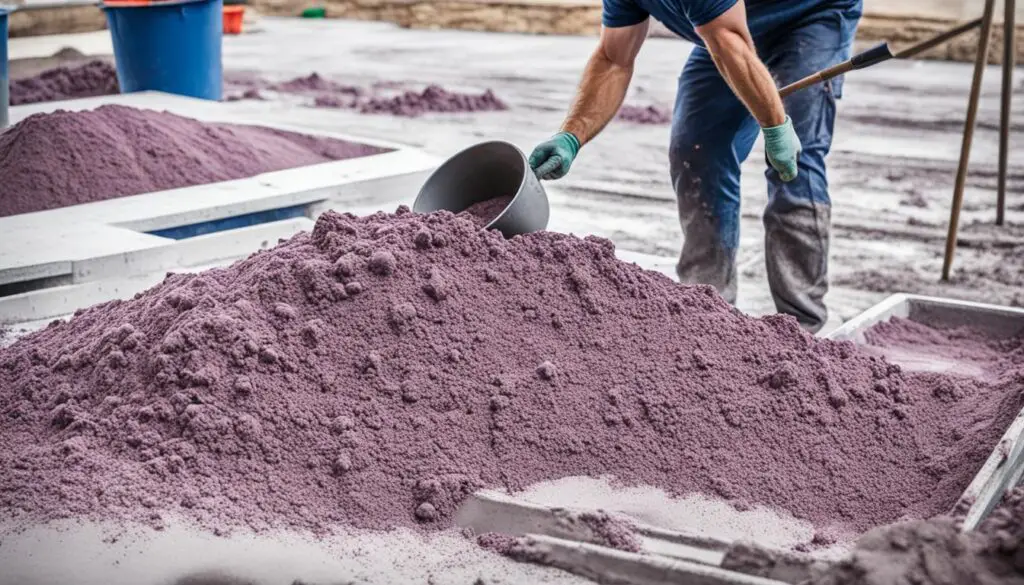
- Selection of Plums: Choose large stones or boulders, ensuring they are hard and durable enough to withstand pressure without being crushed.
- Wash the Plums: It’s crucial to clean the stones to remove any dirt or debris that could interfere with the bonding process.
- Prepare the Matrix: Mix cement, sand, and water to form a concrete matrix. This will be used to bind the plums together.
- Layering: Start with a layer of plums at the bottom of the formwork, leaving enough space for the concrete matrix to fill in.
- Filling Gaps: Pour the concrete matrix over the plums, ensuring that it seeps into all the spaces between them, securing them in place.
- Vibration: Use a mechanical vibrator to ensure there are no voids within the concrete and that it is compacted properly around the plums.
- Curing: Once set, cure the plum concrete with water for a minimum of seven days to reach optimal strength.
In the table below, you’ll find a comparative analysis of proportions commonly used in making plum concrete. These portions are important to ensure the integrity and strength of the concrete once cured. Adjustments may need to be made depending on the specific project requirements, and it’s always advisable to consult an engineer for large projects or if you’re unsure.
| Material | Volume Ratio | Comments |
|---|---|---|
| Cement | 1 Part | Fundamental binder in the mix |
| Sand | 2 Parts | Acts as a fine aggregate |
| Aggregate (Plums) | 4 Parts | The essence of plum concrete, providing bulk and strength |
| Water | As required for workability | Essential for chemical reaction and setting |
To sum up, learning how to prepare plum concrete is a process that involves careful selection of materials and meticulous attention to the steps outlined. Not only does this knowledge serve in everyday construction scenarios, but it largely contributes to the longevity and durability of structures, a prime consideration in the domain of civil engineering. The focus on proper proportioning and curing practices cannot be overstressed, as they are the cornerstones of sound plum concrete preparation.
Decoding the Plum Concrete Ratio
Understanding the right plum concrete ratio is pivotal in achieving the desired durability and stability in construction projects. Before we dive into the specifics, it’s essential to acknowledge the critical role this ratio plays in defining the strength of any structure that employs plum concrete. Let’s explore the intricacies of standard mixing practices and calculations that underpin this vital construction material.
Standard Mixing Practices
When it comes to creating an optimal mix of plum concrete, following standardized practices is a must. These practices ensure even distribution of plums and concrete, preventing weak points within the structure. Typically, we aim for a mix where the stone aggregates – or plums – do not exceed 40% of the total volume. This ensures that there is enough supporting matrix to bind the stones without excess, which can compromise the strength and lead to inefficiencies in materials use.
Plum Concrete Calculation
The meticulous art of plum concrete calculation begins with determining the volume of construction work and then fitting in the stones in such a way that they occupy about 30% to 40% of the total volume. These calculations are not standard and must be adjusted based on the size and type of stones available as well as the specific demands of the project at hand.
To provide a clearer picture, let’s take a look at an example calculation:
| Component | Volume | Details |
|---|---|---|
| Plums (Stones) | 0.4 cubic meters | 30%-40% of concrete mix |
| Cement | Variable | Dependent on mix design |
| Sand | Variable | Adjust according to required workability |
| Aggregate | Variable | Balances volume post-plum addition |
| Water | Variable | Subject to desired slump or workability |
The key takeaway from this process is that the plum concrete ratio is not a fixed figure but rather a spectrum that is adjusted for the specifics of each construction project. The field implementation involves keen observation and experience to adjust the mix ratios on-the-spot.

Well-executed plum concrete calculation will result in a cost-efficient, strong, and stable structure, showcasing the material’s full potential.
From these insights into plum concrete ratio and calculation, it is evident that precision is paramount. Such attention to detail does not only reflect in the integrity of the constructed project but also in the judicious use of resources, reinforcing the standing of plum concrete as an economical and durable choice for contemporary construction.
Uses & Applications of Plum Concrete
The versatility of plum concrete as a construction material is truly remarkable. My exploration into its uses & applications reveals a fundamental role it plays in diverse projects. While traditionally associated with oversized infrastructure endeavors due to its economic efficiency and high durability, plum concrete is equally finding its niche within more modest, residential domains. Here, I’ll cast light on the dual domains where plum concrete truly shines.
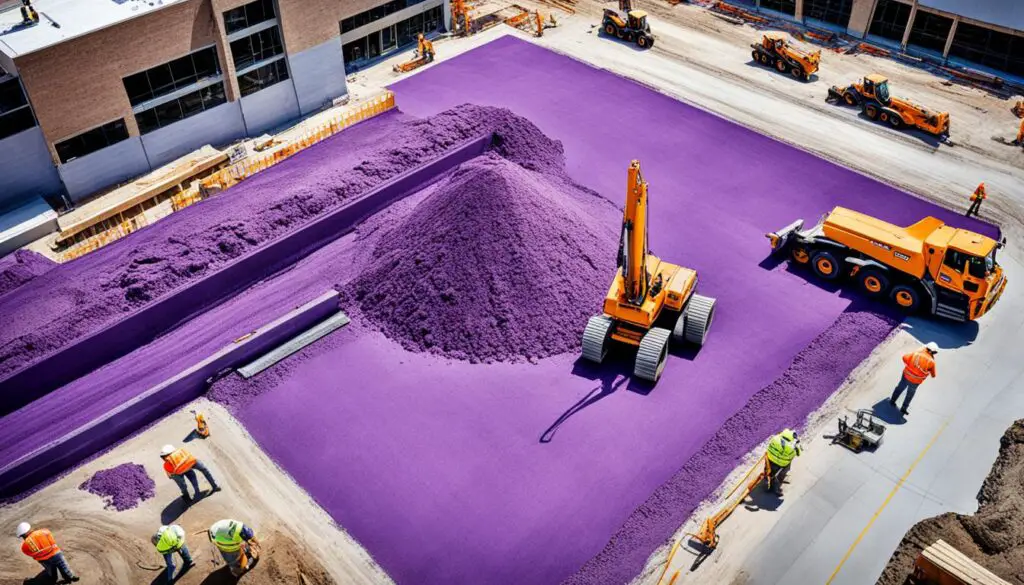
Infrastructure Projects
Where robustness and cost-effectiveness intersect, you’ll find plum concrete in its element. This formidable material has been a game-changer in the realm of infrastructure projects. Its primary claim to fame is the significant role it has played in the construction of gravity dams, where the massive stone elements, or ‘plums,’ contribute to the dam’s stability while also reducing the amount of cement required. Similarly, in the realm of road construction, it serves as a solid foundation layer capable of enduring the incessant traffic demands.
Residential Construction
Shifting our focus to residential construction, the economic benefits of plum concrete become readily apparent. Its application in the foundation beds of homes offers a practical solution for cost-conscious homeowners seeking durability without the substantial price tag. As urban landscapes demand more sustainable and affordable housing, plum concrete provides an accessible alternative that meets structural requirements and stays within budget. This material’s adaptable nature ensures it fits a multitude of residential project scopes, from small homes to expansive housing complexes.
In consideration of the uses & applications of plum concrete, it’s evident that its utility spans a broad spectrum of construction demands. Whether supporting the colossal weight of infrastructure projects or forming the groundwork of a family home, plum concrete remains a linchpin in the fabrication of enduring structures across India. Below is a comparative summary:
| Project Type | Role of Plum Concrete | Key Benefits |
|---|---|---|
| Infrastructure | Supports heavy structures like dams and roads | Strength and cost reduction |
| Residential | Used in foundation beds and load-bearing elements | Affordability and adaptability |
Understanding the diversity in uses & applications of plum concrete is essential for anyone involved in construction, from engineers to project managers. Its role as a staple in large-scale and residential construction projects alike underscores its significance in shaping the future of construction methodologies in India.
Construction Procedure of Plum Concrete
When delving into the construction procedure of plum concrete, it’s quintessential to adhere to precise steps for achieving the durability and stability needed for various types of structures. This entails a progression from preparation to execution, all the while keeping in view the industry benchmarks of quality and safety. The process is quite meticulous, and it is imperative to follow these guidelines to ensure the integrity of the construction work.
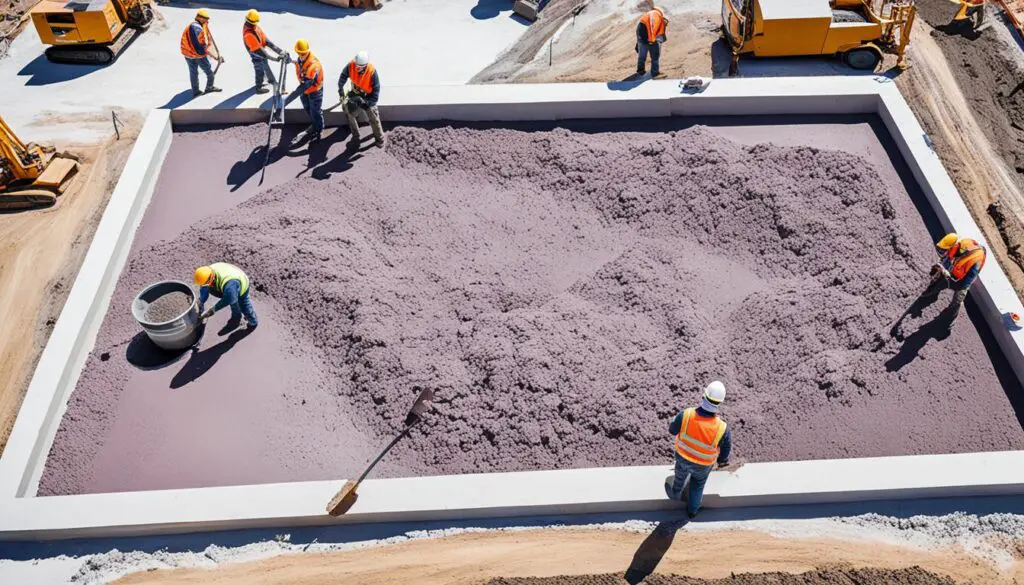
Firstly, the selection of raw materials is critical. Plums, which are the large stones or boulders, must be clean and of the right sizes, usually not less than 300mm, to ensure they provide the necessary bulk and stability within the concrete mix. These plums should account for roughly 20% to 40% of the total volume, depending on the project requirements.
- Inspection and clearance of the site for any debris or unwanted materials.
- Laying the plums out on the cleared surface and examining them for size uniformity and quality.
- Preparing the concrete mix – the ratio usually being 1 part cement, 2 parts sand, and 4 parts gravel.
- Placement of plums in the formwork – ensuring even distribution and avoiding any clustering.
- Filling the voids between the plums with the prepared concrete mix using the pouring method.
- Application of vibration for compaction to eradicate air gaps and promote a unison between the plums and concrete.
- Leveling the top surface followed by the curing process, which could take several days to ensure maximum strength is attained.
Below is a comprehensive table delineating the fundamental parameters that govern the construction procedure of plum concrete in practical scenarios.
| Parameter | Description | Relevance |
|---|---|---|
| Plum Size | Minimum 300mm – can be larger based on project specifications | Ensures proper interlocking and stability within the mix |
| Concrete Mix Ratio | Typically 1:2:4 (Cement:Sand:Gravel) | Provides the necessary binding matrix for the plums |
| Compaction | Use of vibrators or manual rodding | Eliminates air pockets and ensures a dense, homogeneous mix |
| Curing Period | Minimum of 7 days under normal temperature conditions | Develops the desired strength and longevity of the concrete |
It is the attention to these minutiae within the construction procedure of plum concrete that leads to the successful integration of strength and cost-effectiveness in construction ventures, particularly in India where resource optimization is of paramount importance.
Top 10 Advantages of Plum Concrete
When I delve into the realm of construction material, I often find myself advocating for plum concrete due to its numerous benefits. In India, where economic efficiency and sustainability are paramount, plum concrete emerges as a top-tier choice. Let me walk you through the 10 advantages of plum concrete that make it an esteemed asset in the construction industry.

- Economical Use of Materials: The inherent design of plum concrete allows for the strategic use of large stones, reducing the amount of cement required and saving costs substantially.
- Enhanced Durability: The integration of boulders within the concrete mix imparts superior strength, resulting in impressive durability that withstands the test of time and elements.
- Reduced Shrinkage and Cracking: Plum concrete’s unique composition minimizes shrinkage and cracking that often plagues traditional concrete, ensuring a more stable structure.
- Optimal for Massive Constructions: Ideal for large-scale projects like dams and foundations, plum concrete proves to be the pragmatic choice for infrastructural undertakings.
- Resource Efficient: By making use of locally available stones or boulders, plum concrete promotes resource efficiency and supports local economies.
- Lower Greenhouse Gas Emissions: Given that less cement is used, the carbon footprint is reduced, aligning with global efforts toward environmental sustainability.
- Versatility in Application: From foundation beds to erosion control structures, the versatility of plum concrete is unmatched in its myriad uses.
- Minimal Maintenance: The strength and resistance to environmental factors result in low maintenance for structures made with plum concrete.
- High Load-Bearing Capacity: The robust nature of plum concrete enables it to bear substantial loads without compromising structural integrity.
- Conducive to Quick Construction: Owing to easy preparation and laying, construction timelines are often expedited when plum concrete is involved.
Each advantage shines a light on why plum concrete has become such a staple in modern construction here in India. Whether it’s the economic savings or the environmental perks, incorporating plum concrete into a project can lead to outcomes that are both reliable and responsible.
Disadvantages of Plum Concrete
As a construction material, plum concrete has a broad spectrum of applications and benefits, yet it’s crucial to recognize its limitations. My exploration of the 12 disadvantages of plum concrete will shed light on potential challenges that may arise and how they can impact construction projects in India.

Let’s start by understanding that workability and consistency issues can surface due to the large stone sizes used in the mix. These influence the overall handling and can lead to a non-homogeneous structure. In the following table, I will articulate these 12 disadvantages, offering a comprehensive view on where plum concrete may not be the optimal choice.
| No. | Disadvantage | Explanation |
|---|---|---|
| 1. | Limited Workability | Density and sizes of stones may reduce the ease of pouring and compaction. |
| 2. | Poor Consistency | Uneven distribution of stone and concrete mix can result in inconsistent strength. |
| 3. | Complex Placement | The large aggregates can create difficulties in placing and settling the concrete. |
| 4. | Quality Control Challenges | Due to the nature of the material, achieving uniform quality is more challenging. |
| 5. | Compaction Issues | Ensuring proper compaction around the large aggregates can be difficult. |
| 6. | Increased Labor Costs | Additional manual effort required during mixing and placing may raise labor expenses. |
| 7. | Specialized Equipment Needed | Certain projects may need special equipment for placement, contributing to higher costs. |
| 8. | Design Constraint | Architectural and intricate work may be restricted due to the stone sizes. |
| 9. | Not Suitable for Thin Sections | Cannot be used in structures where thinner sections of concrete are required. |
| 10. | Low Tensile Strength | Depending on the stone quality, it may contribute to lower tensile strength. |
| 11. | Difficulty in Alteration | Modifications after setting can be troublesome due to the stone sizes. |
| 12. | Potential for Void Formation | Improper compaction can lead to voids which diminish the structural integrity. |
In conclusion, while plum concrete is a cost-effective and robust choice for certain applications, the outlined disadvantages must be deliberated upon. These facets are particularly significant for those in the field who prioritize precision, consistency, and overall quality in their structures.
Case Studies: Plum Concrete in Action
My investigation into the practical usage of plum concrete led me to explore several large infrastructure projects where the differences between plain cement concrete and plum concrete are markedly clear. Revealing the versatility and efficacy of plum concrete, these case studies illustrate its crucial role in modern construction.
Large Scale Dams and Reservoirs
The sheer scale of dam and reservoir projects requires a robust and economical construction solution. Plum concrete, with its ability to integrate large aggregates, has proven to be a cost-effective alternative to plain cement concrete for such massive structures. Its capacity to distribute stress evenly and reduce the cement content makes it an excellent choice for these applications.
Foundation Beds and Overlays
On the other hand, foundation beds and overlays demand a concrete solution that not only bears significant weight but also provides a stable base for future construction. My analysis of foundational works demonstrates how plum concrete’s enhanced strength and stability surpass the plain cement concrete, ensuring long-term integrity of the structures it supports.
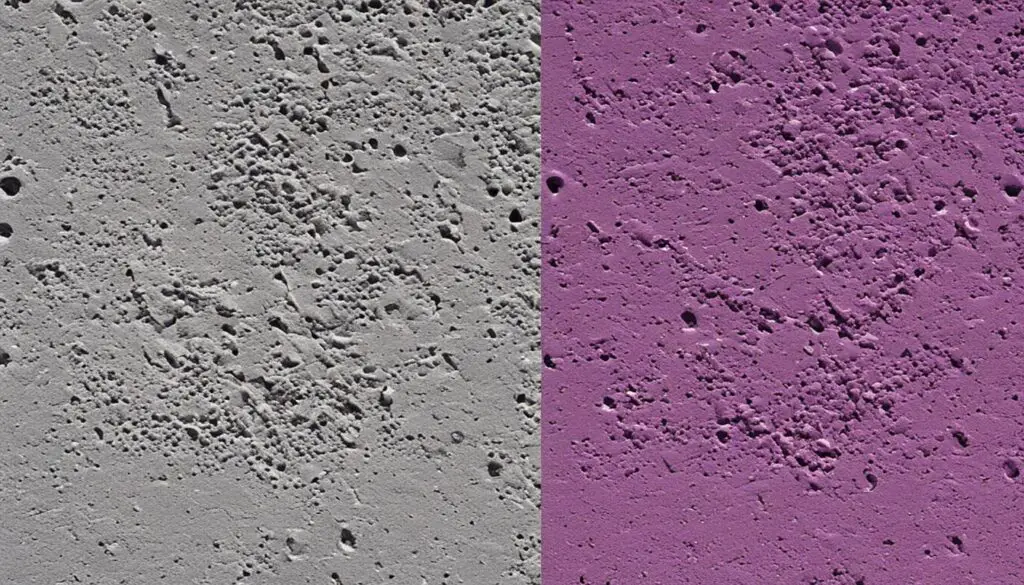
Comparing plum and plain cement concrete, it’s hard to overlook the tailored benefits that plum concrete brings to weighty constructions. The strategic use of larger stones not only economizes the entire mix but also reinforces the final structure.
| Criteria | Plain Cement Concrete | Plum Concrete |
|---|---|---|
| Aggregate Size | Smaller, evenly sized | Larger boulders used |
| Economic Efficiency | Higher cement costs | Lowered cost due to stone volume |
| Structural Load Capacity | Limited by strength of mix | Enhanced by larger aggregates |
| Application in Large Projects | Common, with limitations | Ideal for massive structures |
What emerges from my research is that plum concrete is more than just an alternative form of concrete; it is a specialized choice designed for specific, often grand-scale, construction needs. Where plain cement concrete could falter under the demands of colossal projects, plum concrete provides the strength and cost-efficiency vital for enduring success.
Conclusion
Throughout this comprehensive guide, I’ve taken you through the ins and outs of what is plum concrete?, showcasing its pivotal role in the construction industry. We’ve uncovered that plum concrete is more than just a material; it’s an innovative solution that merges economy with durability, especially beneficial in India’s evolving construction landscape. By integrating large stones into a concrete matrix, plum concrete provides a structurally sound and cost-effective option for a variety of projects.
The specifications of plum concrete have been a focal point in our discussion, outlining how this material is composed and the careful calculations needed to achieve the right mix. We’ve examined its applications, from providing foundational support in infrastructural development to the construction of residential projects. The benefits of this material, coupled with its specific preparations and procedures, have been laid out to ensure that you are well-equipped with the knowledge to use plum concrete effectively.
As we close this guide, I reflect on how the insights shared about plum concrete can significantly enhance construction practices. Whether you’re a seasoned builder or a budding constructor, understanding the specifications, benefits, and applications of plum concrete is crucial. It remains a testament to the ingenuity within the construction industry, presenting both challenges and opportunities. The knowledge imparted here aims to inspire the informed and thoughtful application of plum concrete in your future endeavors, reinforcing its esteemed place within the builder’s toolkit.
Thanks For the Great Attention!
Good Bye & Take Care
Happy Learning
Also, Read,

